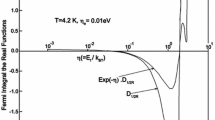Summary
We study the effective electron mass at the Fermi level in Kane-type semiconductors on the basis of fourth order in effective mass theory and taking into account the interactions of the conduction electrons, heavy holes, light holes and split-off holes, respectively. The results obtained are then compared to those derived on the basis of the well-known three-band Kane model. It is found, takingn-Hg1−x Cd x Te as an example, that the effective electron mass at the Fermi level in accordance with fourth-order model depends on the Fermi energy, magnetic quantum number and the electron spin respectively due to the influence of band nonparabolicity only. The dependence of effective mass on electron spin is due to spin-orbit splitting parameter of the valence band in three-band Kane model and the Fermi energy due to band nonparabolicity in two-band Kane model. The same mass exhibits an oscillatory magnetic-field dependence for all the band models as expected since the origin of oscillations in the effective mass in nonparabolic compounds is the same as that of the Shubnikov-de Hass oscillations. In addition, the corresponding results for parabolic energy bands have been obtained from the generalized expressions under certain limiting conditions.
Similar content being viewed by others
References
S. Adachi:J. Appl. Phys.,58, R11 (1985).
B. R. Nag:Electron Transport in Compound Semiconductors (Springer-Verlag, 1980).
R. Dornhaus andG. Nimtz:Springer Tracts Mod. Phys.,78, 1 (1976).
W. Zawadzki:Handbook of Semiconductors, Vol.1 (North-Holland Publ. Co., Amsterdam, 1982), p. 719.
I. M. Tsidilkovskii:Band Structure of Semiconductors (Pergamon Press, Oxford 1982).
M. Mondal andK. P. Ghatak:Phys. Status Solidi B,129, 745 (1985).
W. Zawadzki:Adv. Phys.,23, 435 (1974).
P. R. Wallace:Phys. Status Solidi B,92, 49 (1979).
A. N. Chakravarti, K. P. Ghatak, A. Dhar andK. K. Ghosh:Czech. J. Phys. B,33, 65 (1983).
T. Ando, A. B. Fowler andF. Stern:Rev. Mod. Phys.,54, 437 (1962).
H. Kildal:Phys. Rev. B,10, 5080 (1974).
B. Mitra andK. P. Ghatak:Solid-State Electron.,32, 177 (1989);K. P. Ghatak andM. Mondal:Z. Phys. B,69, 471 (1988).
K. P. Ghatak, B. Mitra andA. Ghoshal:Phys. Status Solidi B,154, K121 (1989);M. Mondal, N. Chattopadhyay andK. P. Ghatak:J. Low Temp. Phys.,66, 131 (1987).
M. Mondal andK. P. Ghatak:Phys Lett. A,131, 529 (1988).
K. P. Ghatak, B. Mitra andS. N. Biswas:Fizika (Alma-Ata),21, 395 (1989).
E. D. Palik, G. S. Picus, S. Teitler andR. E. Wallis:Phys. Rev.,122, 475 (1961).
E. O. Kane:J. Phys. Chem. Solids,1, 249 (1959).
P. Y. Lu, C. H. Wang, C. M. Williams, S. N. G. Chu andC. M. Stiles:Appl. Phys. Lett.,49, 1372 (1986).
F. Koch:Springer Ser. Solid State Sci.,53, 20 (1984).
J. S. Blakemore:Semiconductor Statistics (Pergamon Press, London, 1962).
A. J. Ponomarev, G. A. Potapov, G. I. Kharus andI. M. Tsidilkovskii:Sov. Phys. Semicond. (Engl. Transl.),13, 502 (1979).
L. M. Roth andP. N. Argyres:Semiconductors and Semico Semi-metals, Vol.1, edited byP. K. Willardson andA. C. Bear (Academic Press, New York, N. Y., 1966), p. 168.
V. A. Vilkotskii, D. S. Domanevskii, R. D. Kakanov andV. V. Krasovskii:Sov. Phys. Semicond. (Engl. Transl.),13, 553 (1979).
G. L. Hansen, J. L. Schmit andT. N. Casselman:J. Appl. Phys.,63, 7079 (1982).
V. G. Sredin, V. G. Savitskii, Ya. V. Danilyuk, M. V. Miliyanchuck andI. V. Petrovich:Sov. Phys. Semicond. (Engl. Transl.),15, 249 (1981).
Author information
Authors and Affiliations
Rights and permissions
About this article
Cite this article
Ghatak, K.P., Ghoshal, A. & Mitra, B. Influence of magnetic quantization on the effective electron mass in Kane-type semiconductors. Il Nuovo Cimento D 13, 867–880 (1991). https://doi.org/10.1007/BF02457174
Received:
Published:
Issue Date:
DOI: https://doi.org/10.1007/BF02457174




